
Unilateral Biportal Endoscopy Market Size, Share & Trends Analysis Report By Product (Reusable, Single-Use), By Application (Decompression, Deherniation), By End Use, By Region, And Segment Forecasts, 2025 - 2030
- Report ID: GVR-4-68039-941-7
- Number of Report Pages: 150
- Format: PDF
- Historical Range: 2018 - 2023
- Forecast Period: 2025 - 2030
- Industry: Healthcare
Unilateral Biportal Endoscopy Market Trends
The global unilateral biportal endoscopy market size was estimated at USD 941.3 million in 2024 and is projected to grow at a CAGR of 6.0% from 2025 to 2030. Increasing demand for minimally invasive or key-hole surgeries for diagnostic and therapeutic purposes is expected to drive the overall growth. Advancements in the field of robotic surgery and visually advanced endoscopic procedures are expected to drive the demand for spinal endoscopic procedures. For instance, in October 2023, joimax introduced its latest iLESSYS biportable, interlaminar endoscopic surgical system designed for spinal disorder treatment at both EUROSPINE 2023 and the SMISS Annual Forum.
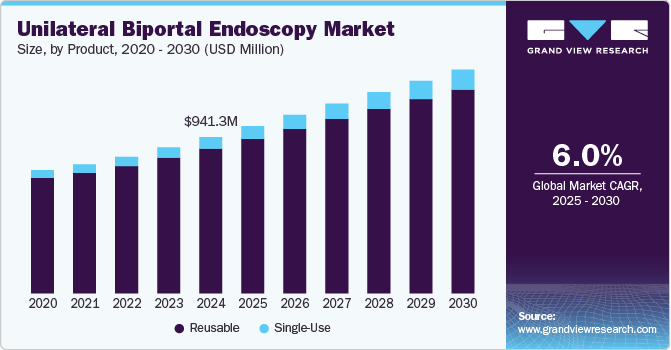
In addition, the growing awareness levels of the benefits of these procedures, such as reduced hospitalization, shortened operating time, minimal collateral tissue damage, and quicker recovery, are boosting demand and contributing to market development. Emergence of advanced visualization technologies is complementing the growing demand for minimally invasive surgeries and is expected to positively influence the market for unilateral biportal endoscopy over the forthcoming years.
Some of these innovations are advanced image-guided technology, flexible radiolucent spinal implants, 3D printing of disc tissue, and bone fusion. The use of computer-assisted image guidance for spine localization is constantly evolving and is delivering real-time image datasets. Moreover, these advancements focus on the development of lesser noninvasive surgical techniques, preservation of motion in the operated spinal segment, minimum postoperative pain and complications, and reduction in recovery time.
Artificial Intelligence (AI) and machine learning are gaining popularity in the field of spinal surgery. AI aids in surgical decision-making and running data analysis on image datasets by enhancing the surgeon and endoscopist’s data processing capabilities. Moreover, the growing number of healthcare facilities such as hospitals, ambulatory surgery centers, and specialty clinics is anticipated to boost the demand for unilateral biportal endoscopies over the forecast period. Furthermore, numerous professionally owned and managed ambulatory surgery centers are gaining popularity, with endoscopists carrying out minimally invasive surgeries in these outpatient settings. For instance, in 2021, there were 1,300 hospitals in Canada. The European Union has around 15,000 hospitals. Moreover, the UK has 1148 hospitals as of August 2023
Furthermore, rapid technological advancements in disposable endoscopes improved the quality of the processed image, enhanced patient safety, and improved workflow management throughout the procedure. For instance, in July 2024, Integrated Endoscopy, a medical device company, introduced its advanced Nuvis Wireless Camera System. It offers health centers and surgeons next-generation wireless communication at a cost below that of traditional corded cameras.
The global geriatric population is growing at an alarming pace and is susceptible to spinal deformities and degenerative diseases. According to the WHO report, by the year 2030, one in six individuals globally will be 60 years old or older. During this period, the number of people aged 60 and above will rise from 1 billion in 2020 to 1.4 billion. By 2050, the global population of individuals who are 60 years older will reach 2.1 billion, effectively doubling. Growing elderly population is expected to boost the demand for various endoscopic procedures such as gastrointestinal, stomach, esophagus, cervical, orthopedic, and pulmonary endoscopy.
Market Concentration & Characteristics
Technological advancements significantly impacted the field of disposable endoscopic devices, driving innovation and improving patient care. These advancements have led to the development of more advanced and sophisticated disposable endoscopes, offering enhanced imaging capabilities, improved maneuverability, and ease of use. For example, integrating high-definition cameras and advanced optics resulted in sharper & more precise images, aiding in accurate diagnosis and treatment. For instance, in January 2024, Mindray launched the UX Series 4K/NIR Endoscope Camera System, developed to provide surgeons with more precise and clear images during minimally invasive surgeries.
The market is characterized by a moderate level of merger and acquisition (M&A) activity by the leading players. This is due to several factors, including the desire to expand the business to cater to the growing demand for unilateral biportal endoscopy.
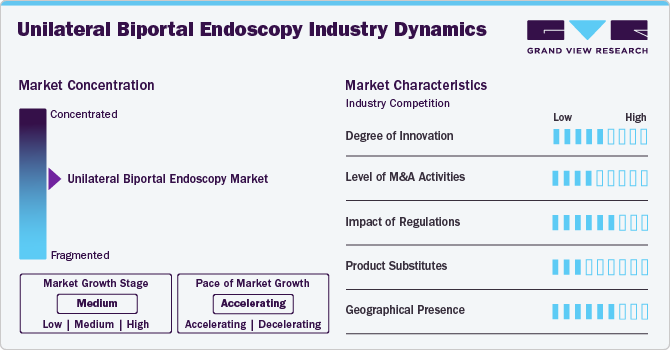
Regulatory bodies, such as the FDA and EMA, impose stringent requirements for safety, efficacy, and quality, which can delay the introduction of innovative UBE devices. These regulations ensure that new technologies meet high standards, ultimately benefiting patient safety and clinical outcomes. In addition, variations in regulations across regions can create barriers for companies looking to expand globally, potentially limiting market growth.
Open surgery and single portal endoscopy serve as primary substitutes in the market. Open surgery often provides better visualization and access but comes with longer recovery times and higher complication rates.
Several market players are expanding their business by entering new geographical regions to strengthen their market position and expand their product portfolio. Rising product approvals and funding create more opportunities for market players to enter new regions.
Product Insights
In 2024, the reusable segment dominated the market and accounted for the largest revenue share. The traditional practice of using reusable products by surgeons and endoscopists due to their recoverability rate and categorization based on exposure to infection risk is fostering segmental growth. Furthermore, advancements in sterilization technologies and materials have enhanced the safety and durability of reusable instruments. Furthermore, increasing endoscopy procedures will supplement market growth. For instance , according to the NHS report, by March 2025, 95% of patients will be scheduled for their endoscopy procedure within 6 weeks.
The single-use segment in the market is anticipated to witness the fastest expansion, with a CAGR of 9.3% over the forecast period. Increasing demand for single-use endoscopes to mitigate the risk of device-related infections is escalating market growth. Factors such as patient preference for minimally invasive procedures, supportive regulatory frameworks, and favorable reimbursement policies in developed countries also contribute to market growth. The growing adoption of MIS is expected to boost the global market over the coming years. Key advantages include high patient acceptance rates, reduced pain, cost-effectiveness, and lower chances of complications. NIH data from January 2023 indicates an increasing trend of ambulatory minimally invasive procedures in the U.S., which raises the demand for disposable endoscopes in these settings.
Application Insights
In 2024, the decompression segment dominated the market and accounted for the largest revenue share of 40.0%. The non-invasive characteristics and faster recovery of this procedure segment are expected to enhance the growth of this segment. The decompression technique allows for direct anatomical visualization while reducing collateral tissue damage. In addition, benefits such as minimized collateral tissue damage, faster and assured recovery, small incision, and minimal blood loss are driving segment growth. Furthermore, degenerative lumbar canal stenosis is the highest revenue-generating indication for decompression procedures since it prevents paraspinal muscle atrophy, reduced muscle dissection, and retraction when compared to conventional open surgical methods.
The lumbar spinal stenosis segment in the market is anticipated to witness the fastest CAGR over the forecast period. Increasing prevalence of lumbar spinal stenosis, advancements in surgical techniques, and rising patient demand for minimally invasive options are boosting segmental growth. Furthermore, as the aging population grows, the incidence of lumbar spinal stenosis increases, leading to a higher demand for effective treatment solutions. For instance, according to a report from the National Library of Medicine released in 2023, research indicates that approximately 1 in 1,000 individuals aged 65 and older and around 5 in 1,000 individuals over 50 are at risk of developing spinal stenosis. It is expected that the number of cases will rise to about 18 million within the next ten years.
End use Insights
In 2024, the hospitals segment dominated the market and accounted for the largest revenue share of 46.4%. Favorable reimbursement policies for patients who visit hospitals as compared to those seeking treatment at ambulatory centers and the presence of a large number of hospitals & primary care centers in developed & developing economies are key factors that can be attributed to the high demand for unilateral biportal endoscopes. According to the American Hospital Association, there are 6,120 hospitals in the U.S. in 2024.
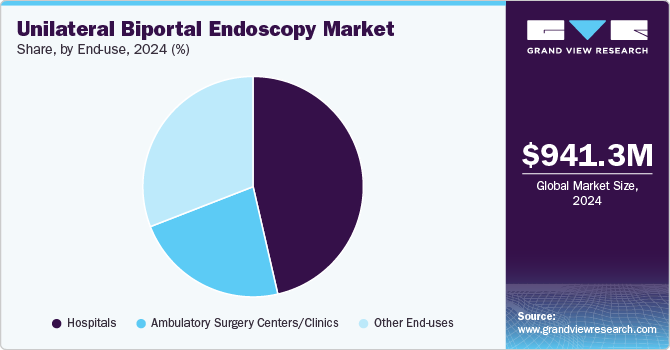
The ambulatory surgery centers/clinics segment is anticipated to witness the fastest CAGR over the forecast period owing to the increasing number of healthcare professionally owned and managed ambulatory care settings to cater to the rising demand for minimally invasive surgeries. Furthermore, the growing preference for same-day surgery, resulting in cost savings and reduced hospitalization, is contributing to the growth of this care delivery segment.
Regional Insights
North America unilateral biportal endoscopy market dominated the global market in 2024 and accounted for the largest revenue share of 41.8%. Consistent product innovations and rising incidences of complex diseases are boosting market growth in North America. The market is also driven by rapid technological advancements in new endoscopy devices and increased adoption on a wide scale.
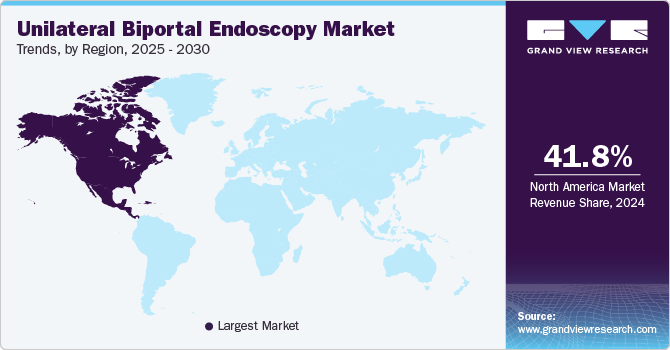
U.S. Unilateral Biportal Endoscopy Market Trends
The U.S. unilateral biportal endoscopy market held the largest revenue share in the North America region in 2024. The growing preference for minimally invasive procedures across various medical specialties in the U.S. is driving the demand for unilateral biportal endoscopes. Moreover, an advanced healthcare infrastructure, high investments by market players and hospitals promoting the use of novel endoscopy equipment, and favorable reimbursement policies are among the factors expected to drive industry expansion in the U.S.
Canada unilateral biportal endoscopy market is anticipated to register the fastest growth during the forecast period. The increasing preference for minimally invasive surgeries for faster recovery, enhanced precision, accuracy, and reduced post-surgery infections & complications is positively impacting market growth.
Europe Unilateral Biportal Endoscopy Market Trends
Europe unilateral biportal endoscopy market is anticipated to register the fastest growth during the forecast period. Ongoing technological advancements in endoscopy and a rise in demand for minimally invasive procedures are among the factors driving the Europe market. Favorable macro environment factors are driving key players to revise their market entry strategies through mergers & acquisitions and technological collaborations to expand their footprint.
The unilateral biportal endoscopy market in Germany is anticipated to register a considerable growth rate during the forecast period. The adoption of endoscopes and endoscopy devices in Germany is expected to be driven by the increasing prevalence of chronic diseases, including lumbar spinal stenosis and lumbar disc herniations, and growing awareness regarding the usage of disposable endoscopy devices.
The UK unilateral biportal endoscopy market is anticipated to register a considerable growth rate during the forecast period. The increasing number of patients suffering from chronic diseases that require minimally invasive surgical procedures for diagnosis & treatment is contributing to market growth. For instance, according to the Migration Observatory, the population of the UK is projected to increase from 67 million in 2021 to 77 million in 2046.
Asia Pacific Unilateral Biportal Endoscopy Market Trends
Asia Pacific unilateral biportal endoscopy market is anticipated to register the fastest CAGR during the forecast period owing to its rapidly improving healthcare infrastructure, a less stringent regulatory framework, and economic development attracting foreign investments.
The unilateral biportal endoscopy market in Japan held the largest share in 2024. The growing geriatric population in the country is fostering market growth. The growing geriatric population, high prevalence of chronic diseases, and consistent product advancements are some factors expected to drive the demand for endoscopy procedures.
China unilateral biportal endoscopy market is anticipated to register considerable growth during the forecast period. The growing presence of trained endoscopists for a broad range of applications, the development of surgical devices to increase indications of endoscopic surgeries, and product advancements are supplementing industry expansion.
Latin America Unilateral Biportal Endoscopy Market Trends
Latin America unilateral biportal endoscopy market is anticipated to grow lucratively during the forecast period. The distribution network of the medical device industry in Latin America is highly fragmented, with multiple small distributing companies providing easy accessibility to endoscopy devices.
Brazil unilateral biportal endoscopy market is anticipated to register considerable growth during the forecast period. The increasing geriatric population and rising prevalence of various chronic diseases are anticipated to propel market growth. Furthermore, rising awareness about disposable endoscopes is boosting their adoption.
MEA Unilateral Biportal Endoscopy Market Trends
The MEA unilateral biportal endoscopy market is anticipated to register the fastest growth during the forecast period. MEA is a key economic and technologically advanced region with a high per capita disposable income. Government initiatives to increase reimbursement coverage are a key factor expected to boost market growth during the forecast period.
The South Africa unilateral biportal endoscopy market is anticipated to register considerable growth during the forecast period. South Africa has a well-developed healthcare sector focused on providing advanced medical services and technologies to its population. The need to deliver high-quality healthcare services, accurate diagnoses, and minimally invasive treatments is increasing the demand for unilateral biportal endoscopes in South Africa.
Key Unilateral Biportal Endoscopy Company Insights
Key participants in the market for unilateral biportal endoscopy are focusing on devising innovative business growth strategies in the form of product portfolio expansions, partnerships & collaborations, mergers & acquisitions, and business footprint expansions.
Key Unilateral Biportal Endoscopy Companies:
The following are the leading companies in the unilateral biportal endoscopy market. These companies collectively hold the largest market share and dictate industry trends.
- Endovision Co. Ltd.
- Karl Storz
- Smith & Nephew
- Stryker Corporation
- CONMED Corporation
- Maxer Endoscopy GmbH
- Joimax GmbH
- Richard Wolf
- Jiangsu Bonss Medical Technology Co. Ltd.
- Kinetix Lifesciences
Recent Developments
-
In July 2024, Integrated Endoscopy, a medical device company, introduced its advanced Nuvis Wireless Camera System. It offers health centers and surgeons next-generation wireless communication at a cost below that of traditional corded cameras.
-
In April 2021, Erbe Elektromedizin announced the acquisition of a German company, Maxer Endoscopy, a manufacturer of endoscopic systems and instruments. Through this acquisition, Erbe Elektromedizin is expected to offer fluorescence-guided and 4K systems for endoscopy. The acquisition can aid Erbe Elektromedizin in expanding its visualization portfolio, as Maxer’s major innovation focus is the development of high-end visualization technology.
-
In May 2021, Pentax Medical & Jiangsu Vedkang Medical Science and Technology collaborated and developed disposable therapeutic products for flexible endoscopy. Under this joint venture, Pentax Medical is to offer its sales & distribution network, and Jiangsu Vedkang is to utilize its production & R&D capabilities.
Unilateral Biportal Endoscopy Market Report Scope
|
Report Attribute |
Details |
|
Market size value in 2025 |
USD 1.01 billion |
|
Revenue forecast in 2030 |
USD 1.35 billion |
|
Growth Rate |
CAGR of 6.0% from 2025 to 2030 |
|
Actual data |
2018 - 2023 |
|
Forecast data |
2025 - 2030 |
|
Quantitative units |
Revenue in USD million/billion and CAGR from 2025 to 2030 |
|
Report coverage |
Revenue forecast, company ranking, competitive landscape, growth factors, and trends |
|
Segments covered |
Product, application, end use, region |
|
Regional scope |
North America, Europe, Asia Pacific, Latin America, MEA |
|
Country scope |
U.S., Canada, Mexico, Germany, UK, Spain, Italy, France, Norway, Denmark, Sweden, Japan, China, India, Australia, Thailand, South Korea, Brazil, Argentina, South Africa, Saudi Arabia, UAE, Kuwait |
|
Key companies profiled |
Endovision Co. Ltd., Karl Storz, Smith & Nephew, Stryker Corporation, CONMED Corporation, Maxer Endoscopy GmbH, Joimax GmbH, Richard Wolf, Jiangsu Bonss Medical Technology Co. Ltd., Kinetix Lifesciences |
|
Customization scope |
Free report customization (equivalent up to 8 analysts working days) with purchase. Addition or alteration to country, regional & segment scope. |
|
Pricing and purchase options |
Avail customized purchase options to meet your exact research needs. Explore purchase options |
Global Unilateral Biportal Endoscopy Market Report Segmentation
This report forecasts revenue and volume growth at global, regional, and country level and provides an analysis on industry trends in each of the sub segments from 2018 to 2030. For this study, Grand View Research, Inc. has segmented the global unilateral biportal endoscopy market report based on product, application, end use, and region:
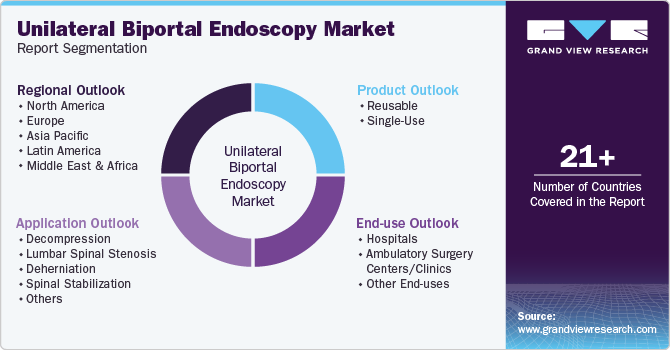
-
Product Outlook (Revenue, USD Million, 2018 - 2030)
-
Reusable
-
Single use
-
-
Application Outlook (Revenue, USD Million, 2018 - 2030)
-
Decompression
-
Lumbar Central Canal Stenosis
-
Degenerative Lumbar Canal Stenosis
-
-
Lumbar Spinal Stenosis
-
Deherniation
-
Spinal Stabilization
-
Others
-
-
End Use Outlook (Revenue, USD Million, 2018 - 2030)
-
Hospitals
-
Ambulatory Surgery Centers/Clinics
-
Other end uses
-
-
Regional Outlook (Revenue, USD Million, 2018 - 2030)
-
North America
-
U.S.
-
Canada
-
Mexico
-
-
Europe
-
Germany
-
UK
-
Spain
-
Italy
-
France
-
Denmark
-
Norway
-
Sweden
-
-
Asia Pacific
-
Japan
-
China
-
India
-
Australia
-
Thailand
-
South Korea
-
-
Latin America
-
Brazil
-
Argentina
-
-
MEA
-
South Africa
-
Saudi Arabia
-
UAE
-
Kuwait
-
-
Frequently Asked Questions About This Report
b. The global unilateral biportal endoscopy market size was estimated at USD 941.3 million in 2024 and is expected to reach USD 1.01 billion in 2025.
b. The global unilateral biportal endoscopy market is expected to grow at a compound annual growth rate of 6.0% from 2025 to 2030 to reach USD 1.35 billion by 2030.
b. North America dominated the unilateral biportal endoscopy market with a share of 41.8% in 2024. This is attributable to factors such as developed & evolving healthcare infrastructure, growing geriatric population & rising prevalence of non-communicable diseases, widespread adoption of advanced technologies, presence of key players, and increase in awareness about advantages of minimally invasive surgeries.
b. Some key players operating in the unilateral biportal endoscopy market include Endovision Co. Ltd, Maxer Endoscopy GmbH, Karl Storz, Richard Wolf, Stryker Corporation, Smith & Nephew, CONMED Corporation, Jiangsu Bonns Medical Technology, Kinetix Lifesciences, and joimax GmbH.
b. Key factors that are driving the unilateral biportal endoscopy market growth include increasing demand for minimally invasive or key-hole surgeries for diagnostic and therapeutic purposes is expected to drive the overall growth. Advancements in the field of robotic surgery and visually advanced endoscopic procedures is expected to drive the demand for spinal endoscopic procedures.
We are committed towards customer satisfaction, and quality service.
"The quality of research they have done for us has been excellent."




